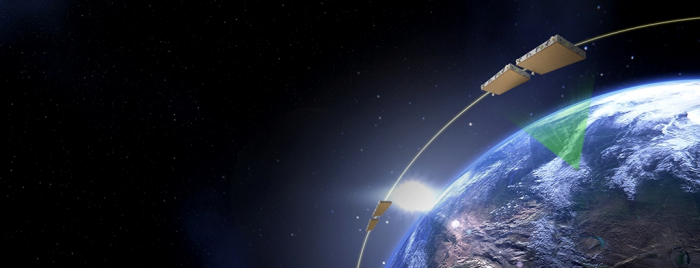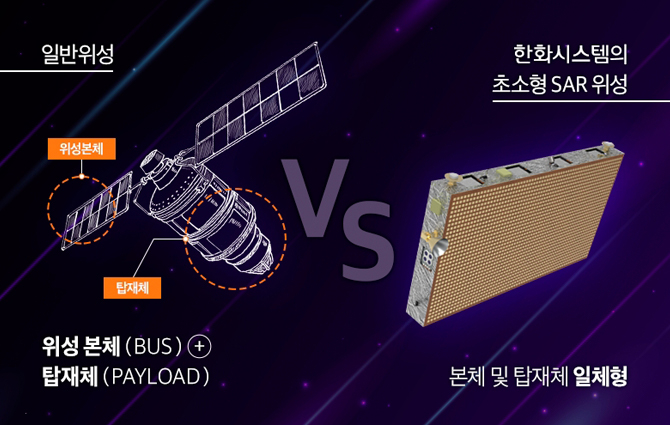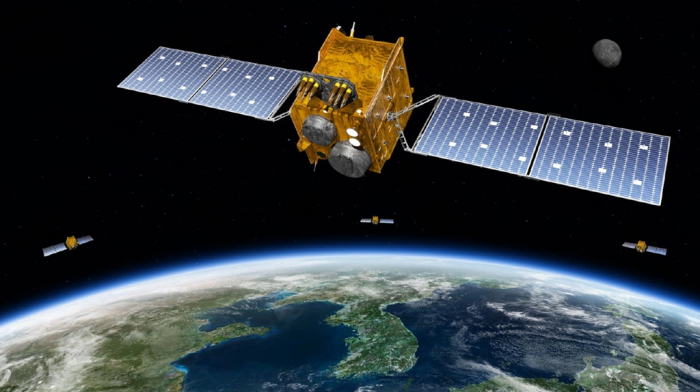Hanwha Systems, KAI sign contracts to develop SAR satellites
Korea aims to launch a cluster of SAR satellites for real-time monitoring of the peninsula
By May 18, 2023 (Gmt+09:00)
LG Chem to sell water filter business to Glenwood PE for $692 million


KT&G eyes overseas M&A after rejecting activist fund's offer


Kyobo Life poised to buy Japan’s SBI Group-owned savings bank


StockX in merger talks with Naver’s online reseller Kream


Meritz backs half of ex-manager’s $210 mn hedge fund



Hanwha Systems Co. and Korea Aerospace Industries Ltd., Korea’s two leading aerospace and defense companies, have clinched deals with a government agency to develop ultra-small satellites called synthetic aperture radar (SAR) systems.
Hanwha Systems, the defense and air mobility unit of Hanwha Group, said on Thursday its contract with the Agency for Defense Development (ADD), a state-run defense technology research institute, is worth 67.9 billion won ($51 million).
Korea Aerospace Industries, commonly known as KAI, the country’s sole military aircraft and weapons manufacturer, also inked a 67.2 billion won deal with the ADD.
Separately, LIG Nex1 Co., another domestic defense company, agreed on a 99.1 billion won deal with the state-run agency to develop ground equipment that operates SAR satellite systems.
SAR technology shoots radio waves from the air to the ground and synthesizes the reflected signals to create an image. As it uses radar instead of visible light, it can be used day and night and in bad weather, making it ideal for Earth observation and military reconnaissance.

Under the deal, Hanwha will develop a SAR validation satellite, which later will lead to the mass production of SAR satellites.
Through the project, Korea aims to launch a cluster of SAR satellites into space to enable real-time monitoring and observation of the Korean Peninsula and the surrounding maritime areas to detect crisis and disaster signs.
Hanwha said it will develop a SAR validation satellite by June 2027.
The company possesses expertise in electronic optics, infrared technology, SAR sensors and data link systems – essential for military reconnaissance satellites weighing 100 kg or less.
Unlike other cylindrical satellites, Hanwha’s SAR satellite will come in the shape of a light, flat and rectangular panel, significantly reducing its weight.
That way, more satellites can be blasted off through a launch vehicle, cutting costs.

GLOBAL KAI 2050 VISION
KAI, under its contract with the ADD, will also develop a SAR validation satellite.
Under the contract, which will last through June 2027, KAI will be responsible for the development, launch and mission tests in space of the SAR satellite.
Through the project, KAI aims to expand its satellite business portfolio from large and medium-sized satellites to smaller ones and promote the exports of such satellites.
Over the past three decades, KAI has participated in various satellite development projects, including multi-purpose satellites, geostationary satellites and next-generation medium-sized satellites.
In 2018, KAI established Korea’s largest private space center, capable of designing, manufacturing and testing satellites.
In January, KAI announced its “Global KAI 2050” vision, designating the space business as one of its six core growth drivers.
Write to Mi-Sun Kang at misunny@hankyung.com
In-Soo Nam edited this article.
-
 Aerospace & DefenseKAI, bastion of South Korea’s fast-growing defense industry
Aerospace & DefenseKAI, bastion of South Korea’s fast-growing defense industryMay 03, 2023 (Gmt+09:00)
3 Min read -
 Aerospace & DefenseHanwha Systems tests AESA radar system for Korean fighter jet
Aerospace & DefenseHanwha Systems tests AESA radar system for Korean fighter jetMar 06, 2023 (Gmt+09:00)
1 Min read -
 Aerospace & DefenseKAI expects 2023 sales to grow by a third, driven by fighter jets
Aerospace & DefenseKAI expects 2023 sales to grow by a third, driven by fighter jetsFeb 15, 2023 (Gmt+09:00)
1 Min read -
 Aerospace & DefenseHanwha takes over satellite technology from gov't institute
Aerospace & DefenseHanwha takes over satellite technology from gov't instituteDec 26, 2022 (Gmt+09:00)
1 Min read -
 Aerospace & DefenseHanwha Systems to build network to share land, sea, air target info
Aerospace & DefenseHanwha Systems to build network to share land, sea, air target infoDec 20, 2022 (Gmt+09:00)
2 Min read -
 Satellite communicationsHanwha Systems to invest $30 mn in US communications firm Kymeta
Satellite communicationsHanwha Systems to invest $30 mn in US communications firm KymetaDec 24, 2020 (Gmt+09:00)
1 Min read -
 Future mobilityHanwha Systems unveils Butterfly, personal air vehicle mockup
Future mobilityHanwha Systems unveils Butterfly, personal air vehicle mockupNov 11, 2020 (Gmt+09:00)
1 Min read


